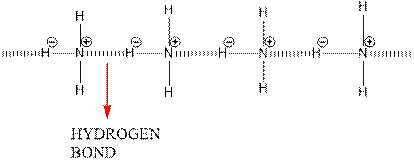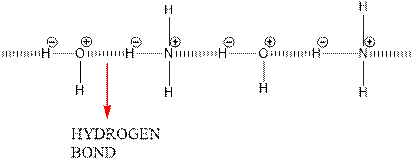
(a)
Interpretation:
Hydrogen bonding between 2 water molecules should be depicted.
Concept introduction:
All types of molecules have some kind of attractive force that keeps them together. Polar molecules that have elements that are high in electro negativity like nitrogen, oxygen and fluorine directly attached to hydrogen atom, exhibit hydrogen bonding. They are held together by hydrogen bonding between molecules.
Hydrogen bonding is a special kind of dipole-dipole bond.
(a)
Answer to Problem 98A
Hydrogen bonding between 2 water molecules is shown below.
Explanation of Solution
In case of
Since oxygen is electronegative centre, it can easily attract hydrogen molecule of other water molecule and hence a partial positive charge develops on it and a partial negative charge develops on hydrogen. This results in intermolecular hydrogen bonding.

(b)
Interpretation:
Hydrogen bonding between 2 ammonia molecules should be depicted.
Concept introduction:
All types of molecules have some kind of attractive force that keeps them together. Polar molecules that have elements that are high in electro negativity like nitrogen, oxygen and fluorine directly attached to hydrogen atom, exhibit hydrogen bonding. They are held together by hydrogen bonding between molecules.
Hydrogen bonding is a special kind of dipole-dipole bond.
(b)
Answer to Problem 98A
Hydrogen bonding between 2 ammonia molecules is shown below.
Explanation of Solution
In case of
Since nitrogen is electronegative centre, it can easily attract hydrogen molecule of other ammonia molecule and hence a partial positive charge develops on it and a partial negative charge develops on hydrogen. This results in intermolecular hydrogen bonding.

(c)
Interpretation:
Hydrogen bonding between water and ammonia molecules should be depicted.
Concept introduction:
All types of molecules have some kind of attractive force that keeps them together. Polar molecules that have elements that are high in electro negativity like nitrogen, oxygen and fluorine directly attached to hydrogen atom, exhibit hydrogen bonding. They are held together by hydrogen bonding between molecules.
Hydrogen bonding is a special kind of dipole-dipole bond.
(c)
Answer to Problem 98A
Hydrogen bonding between water and ammonia molecules is shown below.
Explanation of Solution
In case of
Similarly in case of
Since oxygen is electronegative centre, it can easily attract hydrogen molecule of other ammonia molecule and nitrogen can attract hydrogen molecules of water molecules and hence a partial positive charge develops on oxygen and nitrogen atom. A partial negative charge develops on hydrogen. This results in intermolecular hydrogen bonding.

Chapter 24 Solutions
Chemistry: Matter and Change
Additional Science Textbook Solutions
Chemistry: A Molecular Approach (4th Edition)
Organic Chemistry
Introductory Chemistry (5th Edition) (Standalone Book)
Inorganic Chemistry
Organic Chemistry (8th Edition)
Chemistry: Structure and Properties
 ChemistryChemistryISBN:9781305957404Author:Steven S. Zumdahl, Susan A. Zumdahl, Donald J. DeCostePublisher:Cengage Learning
ChemistryChemistryISBN:9781305957404Author:Steven S. Zumdahl, Susan A. Zumdahl, Donald J. DeCostePublisher:Cengage Learning ChemistryChemistryISBN:9781259911156Author:Raymond Chang Dr., Jason Overby ProfessorPublisher:McGraw-Hill Education
ChemistryChemistryISBN:9781259911156Author:Raymond Chang Dr., Jason Overby ProfessorPublisher:McGraw-Hill Education Principles of Instrumental AnalysisChemistryISBN:9781305577213Author:Douglas A. Skoog, F. James Holler, Stanley R. CrouchPublisher:Cengage Learning
Principles of Instrumental AnalysisChemistryISBN:9781305577213Author:Douglas A. Skoog, F. James Holler, Stanley R. CrouchPublisher:Cengage Learning Organic ChemistryChemistryISBN:9780078021558Author:Janice Gorzynski Smith Dr.Publisher:McGraw-Hill Education
Organic ChemistryChemistryISBN:9780078021558Author:Janice Gorzynski Smith Dr.Publisher:McGraw-Hill Education Chemistry: Principles and ReactionsChemistryISBN:9781305079373Author:William L. Masterton, Cecile N. HurleyPublisher:Cengage Learning
Chemistry: Principles and ReactionsChemistryISBN:9781305079373Author:William L. Masterton, Cecile N. HurleyPublisher:Cengage Learning Elementary Principles of Chemical Processes, Bind...ChemistryISBN:9781118431221Author:Richard M. Felder, Ronald W. Rousseau, Lisa G. BullardPublisher:WILEY
Elementary Principles of Chemical Processes, Bind...ChemistryISBN:9781118431221Author:Richard M. Felder, Ronald W. Rousseau, Lisa G. BullardPublisher:WILEY





